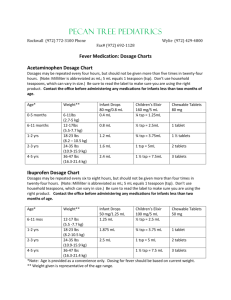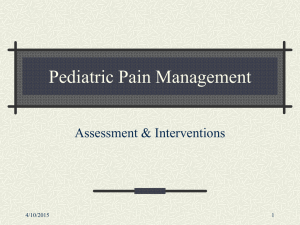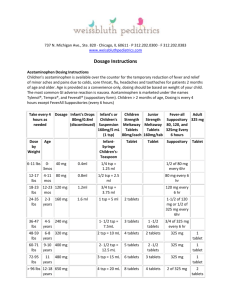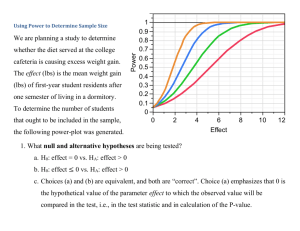Fever Pamphlet - Bayside Pediatrics
advertisement
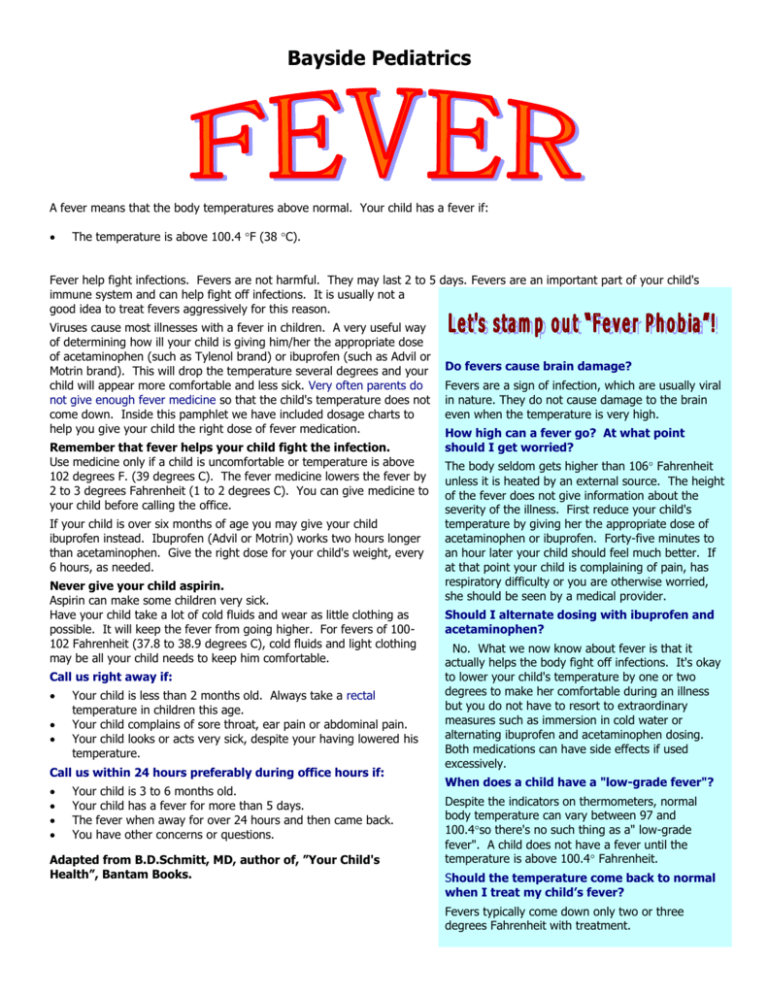
Bayside Pediatrics A fever means that the body temperatures above normal. Your child has a fever if: The temperature is above 100.4 F (38 C). Fever help fight infections. Fevers are not harmful. They may last 2 to 5 days. Fevers are an important part of your child's immune system and can help fight off infections. It is usually not a good idea to treat fevers aggressively for this reason. Viruses cause most illnesses with a fever in children. A very useful way of determining how ill your child is giving him/her the appropriate dose of acetaminophen (such as Tylenol brand) or ibuprofen (such as Advil or Motrin brand). This will drop the temperature several degrees and your child will appear more comfortable and less sick. Very often parents do not give enough fever medicine so that the child's temperature does not come down. Inside this pamphlet we have included dosage charts to help you give your child the right dose of fever medication. Remember that fever helps your child fight the infection. Use medicine only if a child is uncomfortable or temperature is above 102 degrees F. (39 degrees C). The fever medicine lowers the fever by 2 to 3 degrees Fahrenheit (1 to 2 degrees C). You can give medicine to your child before calling the office. If your child is over six months of age you may give your child ibuprofen instead. Ibuprofen (Advil or Motrin) works two hours longer than acetaminophen. Give the right dose for your child's weight, every 6 hours, as needed. Never give your child aspirin. Aspirin can make some children very sick. Have your child take a lot of cold fluids and wear as little clothing as possible. It will keep the fever from going higher. For fevers of 100102 Fahrenheit (37.8 to 38.9 degrees C), cold fluids and light clothing may be all your child needs to keep him comfortable. Call us right away if: Your child is less than 2 months old. Always take a rectal temperature in children this age. Your child complains of sore throat, ear pain or abdominal pain. Your child looks or acts very sick, despite your having lowered his temperature. Call us within 24 hours preferably during office hours if: Your child is 3 to 6 months old. Your child has a fever for more than 5 days. The fever when away for over 24 hours and then came back. You have other concerns or questions. Adapted from B.D.Schmitt, MD, author of, ”Your Child's Health”, Bantam Books. Do fevers cause brain damage? Fevers are a sign of infection, which are usually viral in nature. They do not cause damage to the brain even when the temperature is very high. How high can a fever go? At what point should I get worried? The body seldom gets higher than 106 Fahrenheit unless it is heated by an external source. The height of the fever does not give information about the severity of the illness. First reduce your child's temperature by giving her the appropriate dose of acetaminophen or ibuprofen. Forty-five minutes to an hour later your child should feel much better. If at that point your child is complaining of pain, has respiratory difficulty or you are otherwise worried, she should be seen by a medical provider. Should I alternate dosing with ibuprofen and acetaminophen? No. What we now know about fever is that it actually helps the body fight off infections. It's okay to lower your child's temperature by one or two degrees to make her comfortable during an illness but you do not have to resort to extraordinary measures such as immersion in cold water or alternating ibuprofen and acetaminophen dosing. Both medications can have side effects if used excessively. When does a child have a "low-grade fever"? Despite the indicators on thermometers, normal body temperature can vary between 97 and 100.4so there's no such thing as a" low-grade fever". A child does not have a fever until the temperature is above 100.4 Fahrenheit. Should the temperature come back to normal when I treat my child’s fever? Fevers typically come down only two or three degrees Fahrenheit with treatment. Bayside Pediatrics Handy Dosing Charts Ibuprofen dosing for children under 60 lbs Do not use ibuprofen for children under six months of age You may repeat the Ibuprofen dose every 6 hours as needed Weight Advil drops 50 mg/1.25 ml Older than 6 months 12-17 lbs 18-23 lbs 1.25ml 24-35 lbs Use Children’s Suspension Use Children’s Suspension Use Children’s Suspension Use Children’s Suspension Use Children’s Suspension Use Children’s liquid or Tablets 36-47 lbs 48-59 lbs 60-71 lbs 72-95 lbs 96 lbs or Over 1.875ml Children's liquid 100 mg/5 ml ½ tsp (2.5ml) ¾ tsp (3.75ml) 1 tsp (5ml) 1 ½ tsp (7.5ml) 2 tsp (10ml) 2 ½ tsp (12.5ml) 3 tsp (15ml) 4 tsp (17.5ml) Chewable tabs 100mg each Use Infant or Children’s liquid Use Infant or Children’s liquid Use Infant or Children’s liquid Use Infant or Children’s liquid 2 chewable tablets Junior Strength Swallow Tablets 100 mg each Use Infant or Children’s liquid Use Infant or Children’s liquid Use Infant or Children’s liquid Use Infant or Children’s liquid 2 tablets 2.5 chewable tablets 2 tablets 3 chewable tablets 3 tablets 4 chewable tablets 4 tablets Acetaminophen dosing for children under 60 lbs You may repeat the acetaminophen dose every 4 hours as needed *please read Infant’s Concentration on the bottle carefully. Old bottles were 80mg/0.8ml, and dosing for infants has been changed. Please pay attention to new information below, and use the new syringes that come with the bottles. Weight 6-11 lbs 12-17 lbs 18-23 lbs 24-35 lbs 36-47 lbs 48-59 lbs 60-71 lbs 72-95 lbs Infants’ liquid 160mg/5ml (NEW CONCENTRATION) 1.25ml 2.5ml 3.75ml 5ml Use Children’s Liquid Use Children’s Liquid Use Children’s Liquid Use Children’s Liquid Children's liquid 160mg/5ml Use Infants’ Liquid Use Infants’ Liquid Use Infants’ Liquid 1 tsp (5ml) 1 ½ tsp (7.5ml) 2tsp (10ml) 2 ½ tsp (12.5ml) 3 tsp (15ml) Children's soft chews 80 mg each Use Infants’ Liquid Use Infants’ Liquid Use Infants’ Liquid 2 tablets 3 tablets 4 tablets 5 tablets 6 tablets Junior strength caps or chews 160 mg each Use Infants’ Liquid Use Infants’ Liquid Use Infants’ Liquid Use Children’s Liquid Use Children’s Liquid 2 tablets 2 ½ tablets 3 tablets
